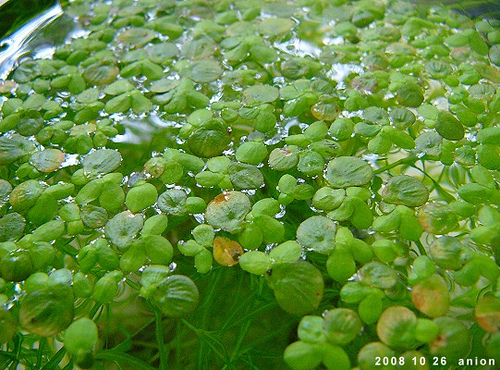Duckweed: Difference between revisions
No edit summary |
No edit summary |
||
| Line 23: | Line 23: | ||
=Links= | =Links= | ||
Wikipedia article on duckweed | Wikipedia article on duckweed [http://en.wikipedia.org/wiki/Duckweed] | ||
July 2008 article on Treehugger | July 2008 article on Treehugger [http://www.treehugger.com/files/2008/07/duckweed-genome.php] | ||
Most comprehensive manual on duckweed aquaculture [http://www.p2pays.org/ref/09/08875.htm] | Most comprehensive manual on duckweed aquaculture [http://www.p2pays.org/ref/09/08875.htm] | ||
Revision as of 17:10, 9 January 2009
Introduction
Aquaculture production of duckweed
The Lemnaceae (duckweed, water lentils) family are the smallest flowering plants. They are free-floating plants with 1 to 3 leaves and a single root (or root-hair) from each frond. Because of their extremely fast growth, duckweeds can be aggressive invaders of ponds and are often considered a nuisance. They grow in dense colonies in quiet water, best if undisturbed by wave action. They require nutrient-rich water that is high in phosphorus and nitrogen and are therefore often found in areas of agricultural run-off. Various species are known and grow in different climates throughout the world. Because of the very high productivity per surface area, duckweed holds great potential for future global villages.
Duckweed as food
Duckweeds can have very high protein content around 50% of dry mass. Vitamin content is high. The taste is remotely similar to spinach. Duckweeds are an element in some cuisines of Asia (e.g. Thai). Because of rapid growth and ease of cultivation, duckweeds are increasingly being considered for consumption by animals and humans. Current uses as animal food are mostly for fish (carp, tilapia) and birds (chicken, duck). Possible uses as part of a human diet are still vastly under-explored but could include duckweed in salad or soup, on a sandwich or as a component of vegetable spread.
Pictures
Ideas and applications for OSE
Human consumption: salad, soup, hummus, in/on bread
For animals: fish food, chicken food,
Links
Wikipedia article on duckweed [1]
July 2008 article on Treehugger [2]
Most comprehensive manual on duckweed aquaculture [3]
Older patent with many details on duckweed for human consumption [4]
"Researchers Find Fuel in Odd Places" [5]
Biolex - a company that uses duckweed to make monoclonal antibodies [6]
Etc...
(note: OSA stands for Open Source Agroecology - or those techniques sufficient for producing local food systems.)
